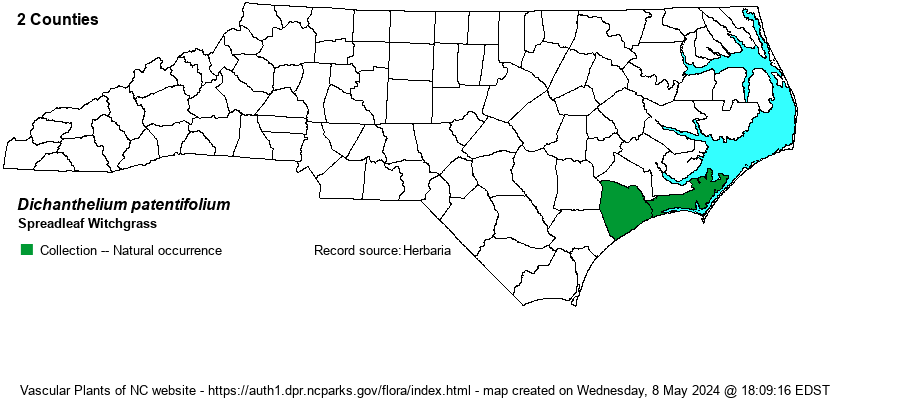| Author | (Nash) Wipff | |
| Distribution | In NC this grass has been collected twice: Camp Lejeune, Onslow County, in 1994 by Richard LeBlond; and near Smiths Swamp in Croatan NF, Carteret County, in 2000 by B.A. Sorrie.
Southeastern VA (Princess Anne Co., 1936); southeastern NC; southeastern GA to south-central FL; southwestern AL to southeastern MS. | |
| Abundance | Not enough data to be reliable. Thus, the editors simply suggest SU (Undetermined) for now. | |
| Habitat | Dry to mesic sandy flatwoods, dry scrub hammocks (in FL), sometimes on slight slopes above wetlands. | |
| Phenology | Flowering in FL begins in April, probably late April-May in NC. Fruits develop later and may still be seen in Oct and Nov. | |
| Identification | Very similar to D. webberianum! Best told by the smooth and glossy fruit in patentifolium vs. papillose (minutely roughened). | |
| Taxonomic Comments | In some old references treated as Panicum patentifolium. Not included in RAB (1968).
A note about Dichanthelium: This genus is not impossible to identify to species! But it takes applied effort over a period of time in order to learn the various species and what their morphological limits are. We strongly recommend that you read the introduction to the treatment in Weakley et al. (2023), written by Richard LeBlond. LeBlond has made order out of near chaos, and his keys work very well for our plants. Most Dichanthelium taxa ("Dichs") do not grow everywhere indiscrimminately, but prefer certain well-defined habitats. Note that most species produce flowers/fruits twice a year -- a vernal period and an autumnal period -- and that measurements of spikelets and achenes are taken from vernal plants. Some species also have a third, or summer, period. In the vernal period there is a single inflorescence at the tip of the stem. In the autumnal period, plants produce elongate branches with bunched (congested) leaves and so look quite different from vernal plants. Inflorescences are produced in leaf axils as well as at the tips of branches. NOTE: Older texts had these species essentially all within the very large genus Panicum. "Dich" species are typically named as "Witchgrass" and Panicum species named as "Panicgrass". | |
| Other Common Name(s) | None? | |
| State Rank | SU | |
| Global Rank | GNR | |
| State Status | | |
| US Status | | |
| USACE-agcp | | |
| USACE-emp | | |

